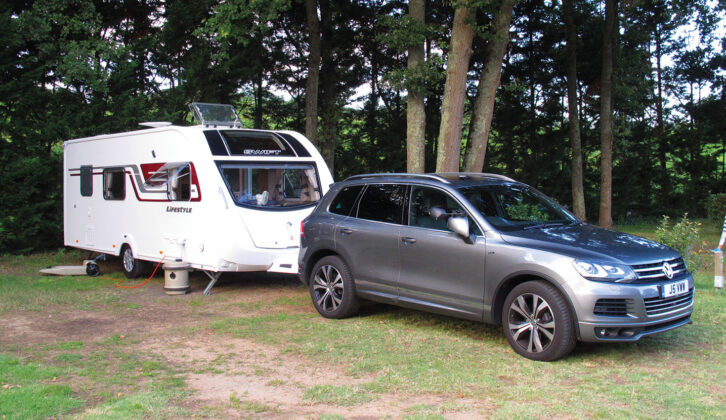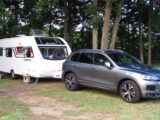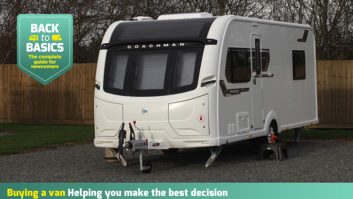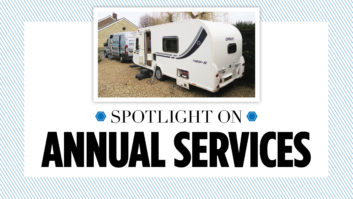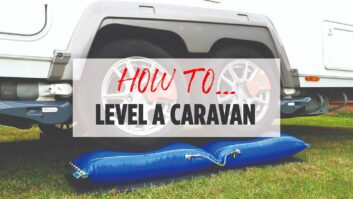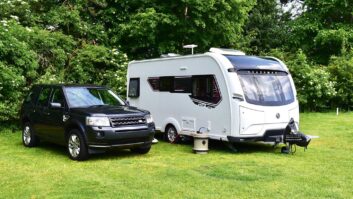To tow your caravan safely and legally, there are some simple sums to calculate. You don’t have to be Pythagoras to tour, but a little knowledge about caravan weights will really help.
In this guide, we’ll run through the rules step-by-step, as well as looking at the numerous terms you need to be aware of to make it as easy as possible for you to tow your tourer with confidence.
Caravan weights – what you need to know:
Let’s start with some of the essential terms you need to be aware of when we’re talking about caravan weights.
MRO/MiRO: Mass In Running Order
This is the weight of the caravan, measured in kilograms, when it leaves the factory and is essentially empty. It does usually include the weight of one gas bottle and an electric hook-up cable; some manufacturers include the weight of some fresh water or fluids, but not all (you should check with them to find out). The figure does not usually allow for a leisure battery.
You’ll find the MiRO and other weights on the weightplate next to the caravan door on most modern tourers.
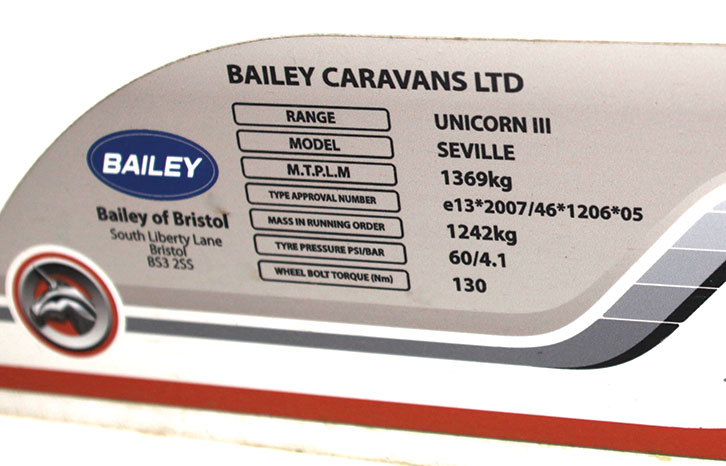
MTPLM: Maximum Technically Permissible Laden Mass
Sometimes also known as Maximum Authorised Mass (MAM), MTPLM is the absolute maximum, total weight at which your van can be towed – you’ll find the figure in kilograms on the weightplate.
For many types of caravan, it will be somewhere between 1000kg (a lightweight two berth caravan) and 2000kg (a large, luxury family caravan).
MTPLM includes everything in or on your caravan, from leisure battery and flush water, to clothing and foodstuffs, plus awnings, motor movers, air-con units, and so on. If you took your fully packed, holiday-ready van to a public weighbridge, the MTPLM is the weight that you must not exceed.
Payload
The payload is the amount of stuff that you can load into your tourer before it becomes ‘overweight’. To calculate it, subtract your MiRO from your MTPLM. This gives you the weight in kilograms that you can take in the caravan, in terms of clothes, food, gadgets, accessories and so on.
For example, on the weightplate shown below, the Bailey’s MTPLM is 1369kg and the MiRO is 1242kg. That leaves a potential payload of 127kg.
Remember, though, that while 127kg sounds like a lot of clothes and food, you also need to include the weight of your leisure battery, plus accessories such as a motor mover (up to 40kg) and satellite dishes (up to 20kg), bedding, footwear, and any TVs or caravan essentials such as awnings (up to 35kg) that travel in the van.
You can help alleviate weight gains by carrying heavy stuff in the tow car boot, or adding a roofbox to your roof-rails.
Noseweight
This is the downward force imposed by the caravan’s hitch head on the tow car’s towball. It is measured in kilograms and should ideally be 5-7% of the caravan’s fully laden weight. For example, a 1500kg van should exert 75-105kg of downward force at the hitch.
You’ll also need to be aware of the car’s towbar limit, which can often be no more than 110kg (and check our guide on how to choose a towbar if you’re looking for one). Check your owner’s manual for details.
You can measure your caravan’s noseweight with a noseweight gauge, which goes between the hitch and the ground. When the jockey wheel is raised, the full weight of the caravan is on the gauge and you can read that weight. Gauges should meet BS7961 standard, and you should always take the measurement on level ground.
Ideally, your van should have a slightly nose-down attitude for the best stability and aerodynamic effect when towing.
Tow car weights – the definitions you need to know:
Kerbweight
This is the empty weight of your caravan tow car. The EU definition of kerbweight usually includes 68kg for the driver and 7kg for sundry luggage; this is typically abbreviated to 75kg for the driver. Some manufacturers include this 75kg in the published kerbweight, and some don’t. This is the weight used to work out your 85% rule calculations.
You should find the kerbweight in the owner’s manual, or on the V5 where it’s listed as the ‘mass in service’. This is the number that you should use, although online you might also find EU, DIN and dry kerbweights, which are all slightly different.
Gross vehicle weight (GVW)and MAM (Maximum Authorised Mass)
Both GVW and MAM are the same thing and describe the maximum weight at which a car can be safely driven, when it’s fully loaded with luggage, people and contents.
If you drive a car above this weight, you are likely to cause damage, and the vehicle might not perform safely.
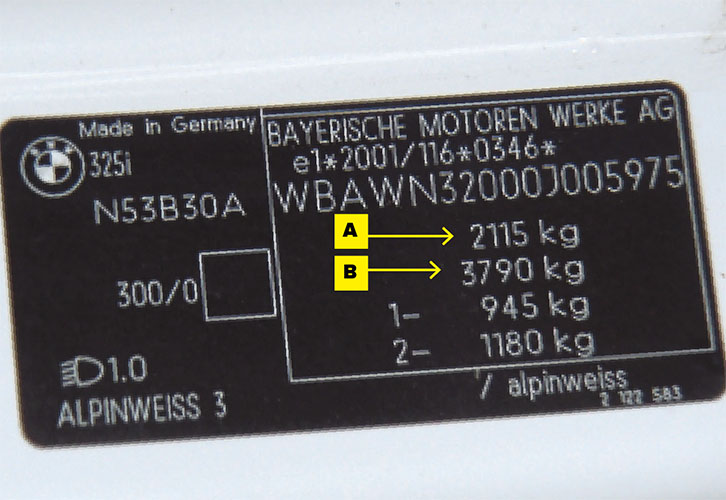
GVW is the weight used in calculating the total mass of a caravan outfit for any B+E purposes. Typically, it will be around 400kg more than the kerbweight, and is the weight you can carry including passengers and content. For example, my car has a kerbweight of 1730kg and, as shown above, a MAM of 2115kg (A). That means I can carry 385kg of people and luggage.
GTW (gross train weight)
This is the combined MAMs of the tow vehicle and the caravan. It is shown on the data plate above as 3790kg (B).
Maximum Towing Limit
You must abide by the car’s towing limit – you can find this by looking in your handbook. Two numbers are usually given – you need the braked trailer figure. You should make sure that your caravan’s weight does not exceed this.
What if I get it wrong?
If you overload your caravan and tow it on public highways, you are putting yourselves and others at risk, as well as potentially invalidating your insurance. This is a legally punishable offence; if found to be towing overloaded, you could have to pay a fine and receive points on your licence. Don’t do it!
The 85% guideline
This guidance, which is recommended by experts and both of the major touring clubs, is not a law, but a very sensible rule.
It states that novice caravanners (see our beginners guide to caravanning if you’re new to the world of touring) should not tow a caravan that weighs more than 85% of their tow car’s kerbweight.
For example, to tow a 1500kg family caravan, your car should weigh 1764kg or more (1500 is 85% of 1764). The car’s maximum towing limit should also be equal to or greater than 1500kg.
Once you have a fair number of towing miles under your belt, and feel you have gained good experience, this ratio can be raised to 100%. That means the same 1764kg tow car could pull a bigger caravan, also weighing 1764kg; again, as long as car’s the maximum towing limit is above 1764kg.
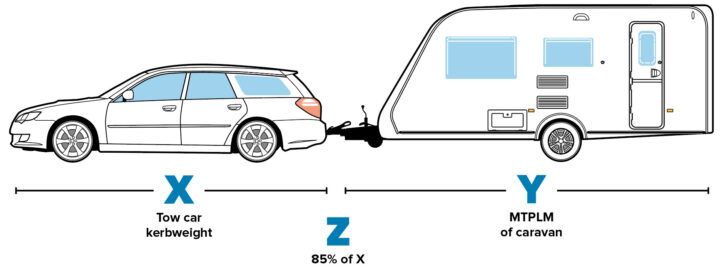
The 85% guideline may not be law, but it’s a very sensible limit to adhere to, and it’s possible that exceeding it could lead to ‘errant caravan antics’, as the heavier tourer ‘bosses’ the tow car.
This in turn, could land you in legal hot water. In short, do not exceed 100%! In the event of an accident, it’s likely the police and your insurers would see this as a contributing factor.
The 85% rule is most troublesome for families who are new to caravanning but really need a bigger tourer. A four- to six berth caravan could weigh over 1500kg, so your tow car needs to be around 1800kg.
We highly recommend everyone sticks to the 85% guideline, no matter what their experience: it creates a more stable outfit.
The B+E licence
Now it’s time to take a look at caravan towing licences. B+E is a UK driving licence category that will (depending on when you passed your test) allow you to operate an outfit with a combined weight (GTW) of up to 8250kg, so long as the MAM of your trailer does not exceed the weight of the unladen vehicle. Until January 1997, it was applied to your licence when you passed your test.
However, after that date, a special B+E towing test had to be taken to gain the category. The training and the test itself cost the best part of £1000, and as the examination was similar to the HGV driving test, the failure rate was quite high.
That all changed on 16 December 2021, when the restrictions were reversed in England, Scotland and Wales. Since that date, these categories have been automatically added to licences – or at least to the DVLA database.
However, in Northern Ireland the test is still required for those passing their driving test after 1 January 1997.
To summarise, if you gained your driving licence before 1 January 1997, you are not affected by the changes of 16 December 2021. You can still drive a vehicle and trailer with a combined weight (GTW) of up to 8250kg.
If you’re in Great Britain and passed your test after 1 January 1997, you can now tow trailers (caravans) up to 3500kg MAM.
Check your vehicle handbook to find your tow car’s GTW. This is the total allowable weight of the outfit – that’s the GVW/MAM of the tow car plus the caravan’s MTPLM.
The DVLA will automatically update your licence record on its database, to show that you can now tow caravans, and the B+E category will be added to your physical driving licence the next time you apply for a new one. However, if you intend to go to the Continent before the due date for your licence renewal, you will have to apply for a new licence before you go so that it shows the BE category.
Loading your caravan
In simple terms, when you’re loading a caravan, the sensible and safest way to is to put the heavier items low down and close to the axle, and the lighter things higher up.
If you get this wrong, you run the risk of an unstable tow, which is more liable to result in a snaking caravan as you drive.
I stow my caravan barbecue and the awning on the floor, in the middle, above the axle (while always respecting the caravan’s payload). Lighter clothes and foodstuffs can go in overhead lockers.
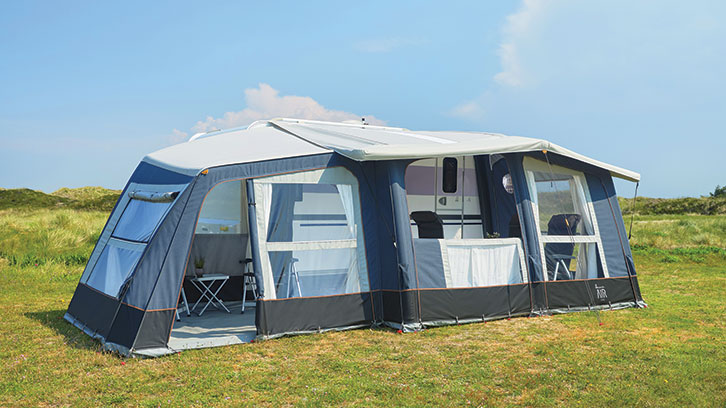
Aim to keep the van slightly ‘nose heavy’, too, by loading some kit towards the front.
Although some caravans have bike racks fitted to the rear panel, you should use these with caution – once loaded with heavy bikes, it could potentially accentuate any pendulum effect when you’re towing. A-frame bike racks are a good idea, or use a rack to transport them on the roof of your car.
Likewise, I tend to only put lightweight stuff in the space under the rear double bed, because I don’t want to have too much weight that far behind the axle.
Gaining weight
The weightplates mentioned earlier show a number of weight limits for your tourer. However, the MTPLM can be raised to allow you to carry a bigger payload.
When ordering a caravan, or even after purchase, you can request the addition of revised weightplates for your tourer. This is often allowable, because a certain amount of leeway is built into the chassis and axle design. Typically, a caravan can have its MTPLM raised by 40-70kg, simply by the addition of a new sticker.
This isn’t a huge amount, but if you’ve added a motor mover, satellite dish, air-con, solar panel or auto-levelling to your van, you might be able to boost its diminished payload back up to a workable level. You can expect to pay £50 to £100 for this. Bailey, for example, charges £65 for many caravan weightplate upgrades.
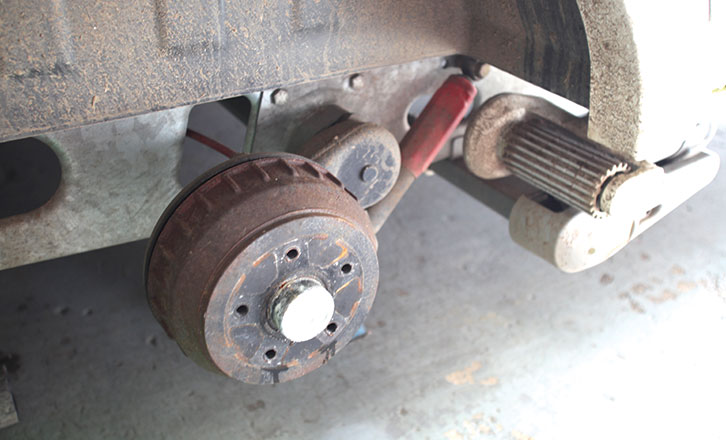
There is another, slightly more extreme method that you can adopt, and that’s to have your axle(s) upgraded. This costs around £1000 each, but in my opinion, caravan manufacturers don’t seem to be hugely enthusiastic about it.
That said, if it’s important to you – for example, for caravanners with disabilities, who can require specialist lifting gear in their tourer – it’s worth inquiring with your dealership in the first instance.
So, to sum up, while the question of caravan weights is a very important one, it doesn’t have to be a tricky subject.
To find out more about caravan and tow car weights, and how to apply them safely, download our free Know-how Guide to Towing.
Future Publishing Limited, the publisher of practicalcaravan.com, provides the information in this article in good faith and makes no representation as to its completeness or accuracy. Individuals carrying out the instructions do so at their own risk and must exercise their independent judgement in determining the appropriateness of the advice to their circumstances. Individuals should take appropriate safety precautions and be aware of the risk of electrocution when dealing with electrical products. To the fullest extent permitted by law, neither Future nor its employees or agents shall have any liability in connection with the use of this information. You should check that any van warranty will not be affected before proceeding with DIY projects.
If you’ve enjoyed reading this article, why not get the latest news, reviews and features delivered direct to your door or inbox every month. Take advantage of our brilliant Practical Caravan magazine SUBSCRIBERS’ OFFER and SIGN UP TO OUR NEWSLETTER for regular weekly updates on all things caravan related.
